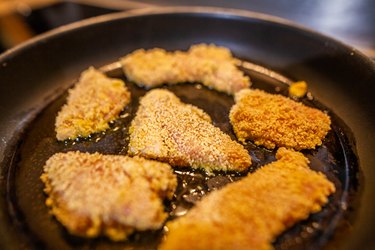
Home-fried foods offer the crisp and gorgeous golden crust so appealing in commercially fried products -- but often without unnecessary salt, sugar and additives added in industrial kitchens. Unfortunately, when you're frying at home, that luscious layer often dissolves in the oil or falls off of the food before crisping up into the desired crunchy coating. Keeping the breading on the food is not all that difficult, once you know a few simple tricks of the trade.
Step 1

Pat dry each piece of food you are frying with paper towels.
Video of the Day
Step 2
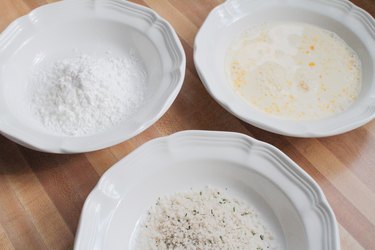
Set out three pie plates or other wide, shallow containers. Fill one with a thick layer of cornstarch. Fill the second about one-third full of milk or milk substitute. Beat an egg into the milk until the mixture is smooth and creamy. Fill the third with a thick layer of flour, breadcrumbs or your coating of choice.
Step 3
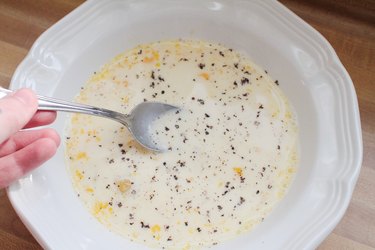
Season the milk and egg mixture with salt, pepper, and herbs and spices you like, matching them to the food that you are frying. For example, add poultry seasoning for fried chicken; chili powder, cumin, thyme and oregano to fish intended for tacos; and a bit of lemon pepper and ginger for Asian vegetables. You may also season the flour or breadcrumbs.
Step 4
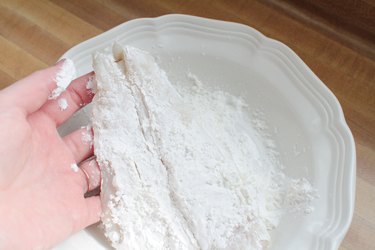
Coat each morsel to be fried first in the cornstarch, covering it completely and shaking off the excess. Dip the coated food into the egg-and-milk mixture, coating it thoroughly. Roll the wet morsel into the dry flour, coating it completely.
Step 5
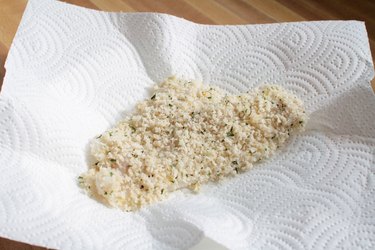
Dip the coated food back into the milk mixture and roll it in the flour again. Pat the coating gently onto the food with your fingertips. Place the double-dipped morsels onto a plate lined with a paper towel as you finish them.
Step 6
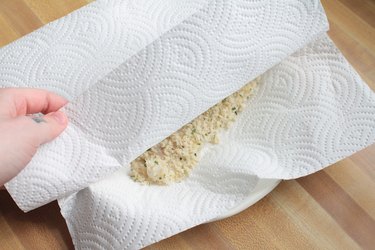
Place a paper towel on top of the coated food. Seal the plate gently with a length or two of plastic cling wrap. Don't pull it too tight, but make sure that all of the edges are sealed. Place the plate into the refrigerator and let the food sit for at least 60 minutes. This helps the coating to harden a bit, which will keep it on the food.
Step 7
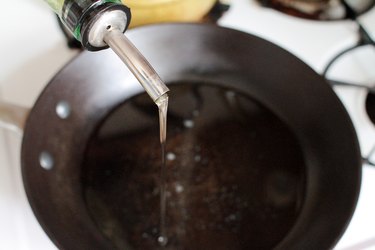
Fill a skillet about halfway full of oil. Heat the oil over medium-high heat until a fry thermometer reads at least 350 degrees F. If you so not have a fry thermometer, the oil is hot when a few crumbs of flour tossed into it sizzle.
Step 8

Place the coated morsels into the hot oil a few at a time, being careful not to crowd the pan. Cook them without moving them according to what kind of food you're preparing – chicken breasts or steak can take seven to nine minutes, while chicken fingers or fish requires four to six minutes. Tougher vegetables may take three to five minutes, and shrimp or scallops can be ready to turn over in as little as one to two minutes.
Step 9
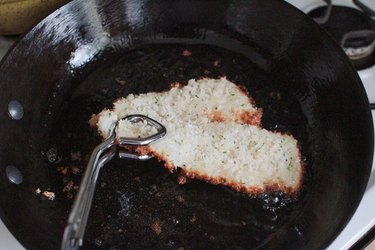
Turn the food carefully with tongs and let it cook for the same amount of time used for the first side. Check the doneness of proteins with an instant-read thermometer. Beef, pork and fish are done at 145 F, while poultry is done at 165 F. Shrimp and scallops are done when they are fully opaque on the inside. Oysters are done when the coating is crisp and golden.
Step 10
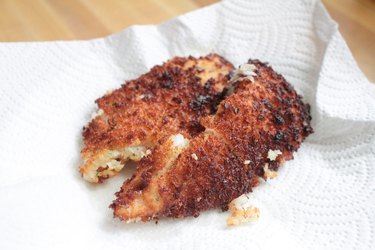
Place fried foods on a clean plate lined with a double-thickness of paper towels to drain. If you are cooking several batches, set the platter into a warm oven to keep them hot.
Things You'll Need
Paper towels
Pie plates
Fork
Cornstarch
Egg
Milk
Flour or breadcrumbs
Seasonings
Plates
Plastic cling wrap
Skillet
Oil
Fry thermometer
Tongs
Instant-read thermometer
Tip
Fry coated foods in small batches. Let the oil come back to its optimal temperature between batches to help seal the coating so that it adheres instead of dissolving.
Warning
Do not use the same platter for cooked foods that you used for the raw, breaded food to avoid possible cross-contamination, especially in the case of meat, poultry or seafood.
Video of the Day